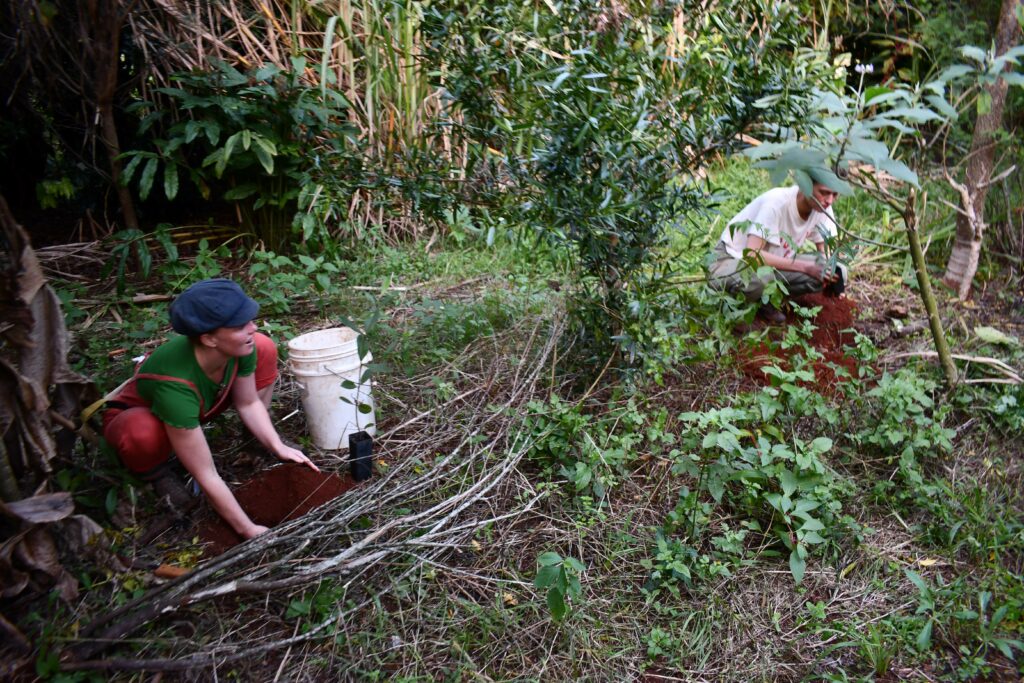Foundation for Rural & Regional Renewal (FRRR)
The wetlands leading to the Kiewa and Murray Rivers will soon be healthier, thanks to Parklands Albury Wodonga’s ‘Restoring Bonegilla’s blue carbon sink wetlands and waterways’ project.
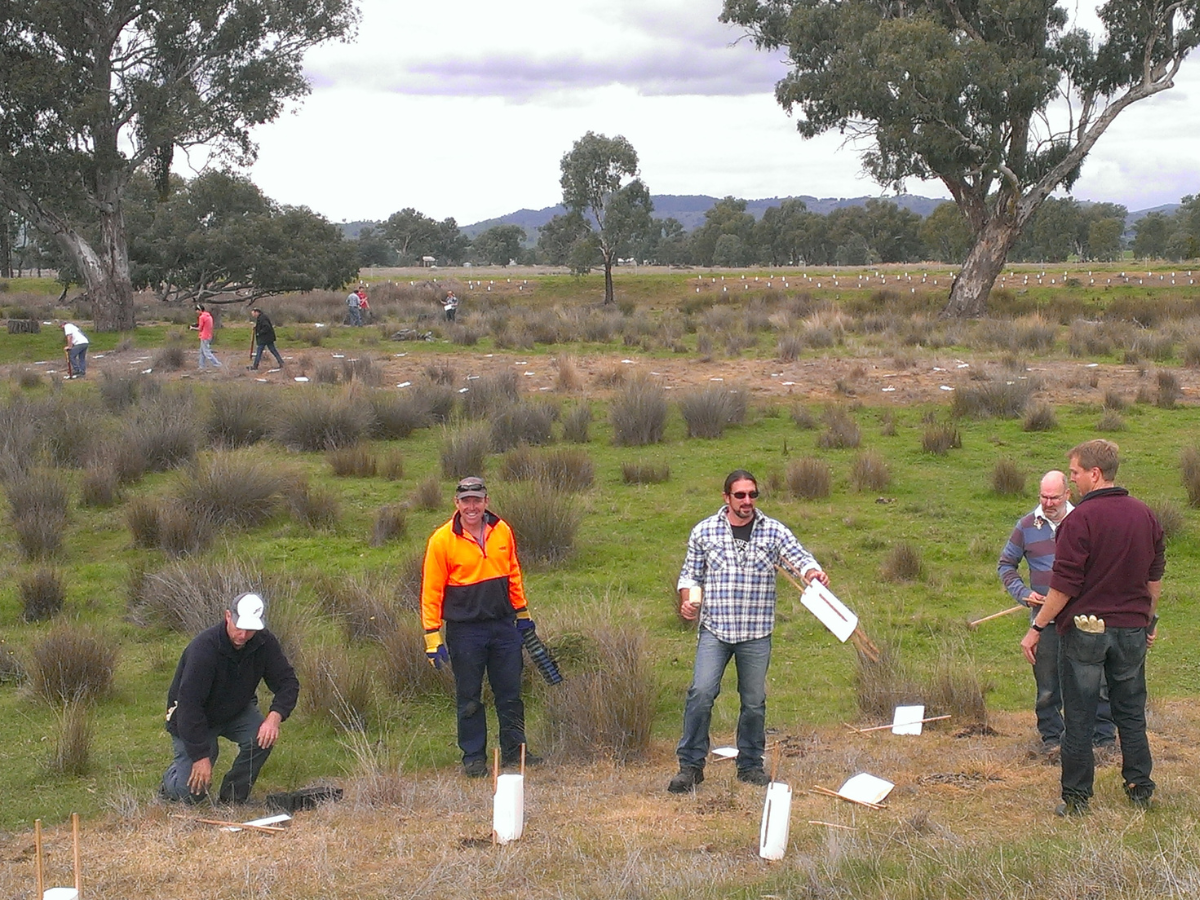
The restoration of wetland plants in floodplain channels and wetlands on these floodplains will capture carbon, slow water runoff and clean the water before it enters major waterways. This will improve water quality, while the restoration of these wetlands will close gaps in current native vegetation corridors, enabling native animals to travel and thereby adapt to the changing climate. The vegetation will also take up atmospheric carbon dioxide, storing it in biomass and sediments.
The project is aligned to decarbonisation and climate adaptation, with strong evidence of community-led development and strong engagement with local Indigenous Elders, disability services and volunteers at the Native Garden Nursery that the group operates.
Since 1997, with the support of more than 3,000 people each year, PAW has been restoring lands degraded by grazing and, more recently a housing development, improving and maintaining the network of bush parks connecting urban and rural communities in the border regions.
A volunteer Committee of Management works closely with the ranger staff to plan and implement rehabilitation, restoration and enhancement of bushlands and parkways for environmental management and recreation.
Volunteers at the nursery have been propagating suitable wetland species from hotter, drier places, which will mean biodiversity resilience as they are planting for a future hotter, drier climate. This well-planned adaptation and restoration project, which received a $16,060 a Community Led Climate Solutions grant, will deliver decarbonisation outcomes and engage the community in planting and developing skills and knowledge for climate solutions activity.
Following the February 2022 floods and the devastation experienced by community members within and surrounding Kin Kin, in southern Queensland, the Kin Kin Community Group (KKCG) shifted its focus towards future planning and the inevitable impacts of another natural disaster on their community. They aim to be better prepared with improved emergency systems to enable their people to operate more efficiently and effectively.
Kin Kin is a secluded southern Queensland hinterland community situated in the Noosa Council area, near its boundary with the Gympie Council. The town has very limited essential services, with only a single general store and café. The February 2022 floods took the town by surprise and left the community fending for themselves. There was no community-friendly meeting place or emergency response centre and the community was cut off by floodwaters for days. No one could enter or leave except by a helicopter from the oval. Food supplies depleted rapidly and communication was hampered, leaving the community in the dark about the ongoing situation. For four days there was limited telecommunication, making the community members feel even more isolated.
KKCG is dedicated to representing and promoting the Kin Kin community, and it was to this organisation that the community turned during their time of distress. The Group operates on behalf of the community, seeking opportunities, positive change and growth for its people. The volunteers are doing all that they can to ensure the community is prepared and supported for the future.
The effects of the 2022 flood events underscored the need for an Emergency Response hub, a place where volunteers and community can gather, to connect, communicate and plan together. The situation also highlighted the scarcity of resources available to support volunteers, including drinking water and first aid equipment. It emphasised the community’s risk areas and disadvantages, illustrating the need for better preparedness in the future.
Fortunately, the KKCG received a grant of $25,000 from the Rebuilding Futures program, funded by the Suncorp Group. This enabled the KKCG to purchase equipment and carry out activities to enhance the community’s safety, connection, resilience and wellbeing. This includes establishing a community hub that is publicly accessible at all times, including during natural disasters, and serves to provide comfort, connection, safety and distribution of essential resources within the community.
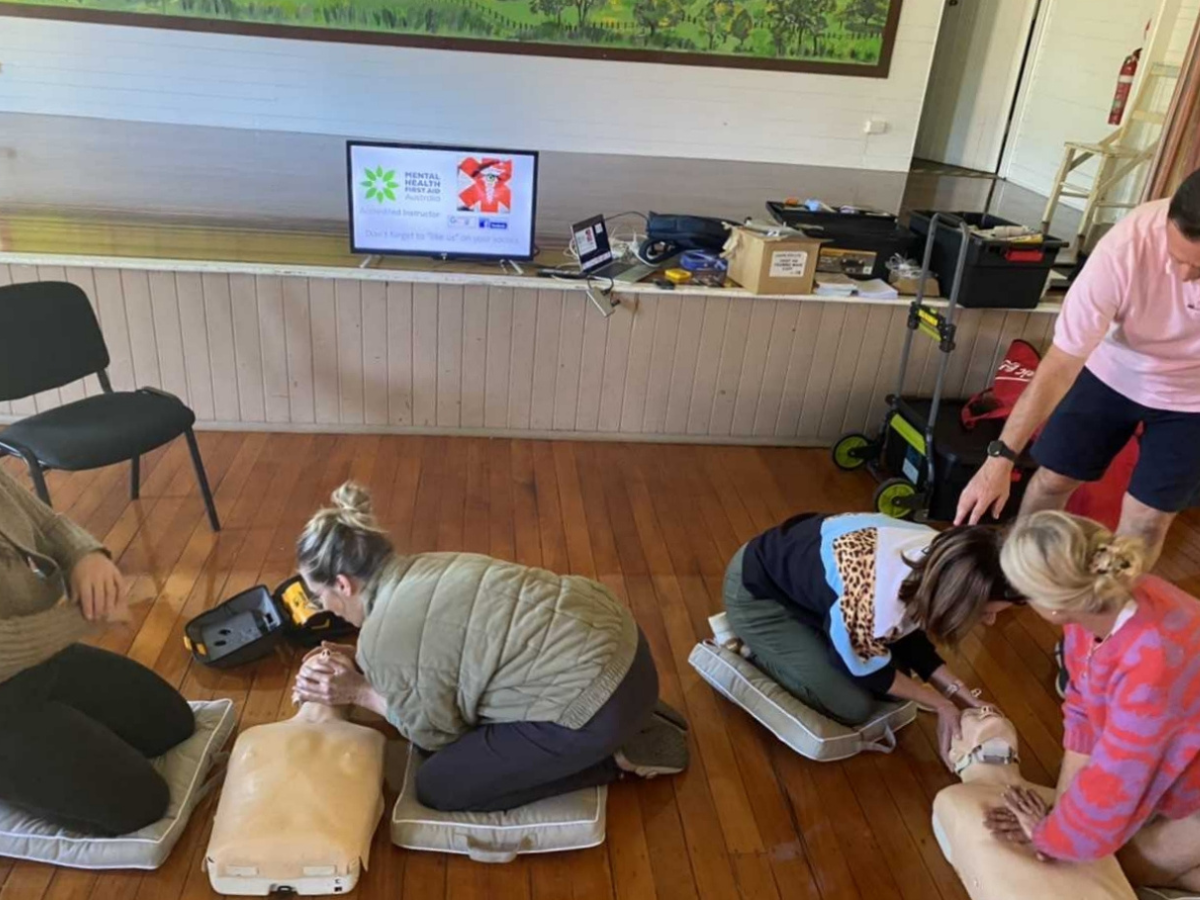
Specifically, the funds went toward essential office equipment such as computers, phones, an air conditioner, a printer, WiFi, first aid kit, a defibrillator, an emergency water supply and a community noticeboard. These resources aid in improving communication and growth within the community. The notice board displays disaster information and preparedness material from the Council and the Queensland Government, designed to better inform the community about disaster preparedness strategies. Furniture was also purchased, to make the space usable for community workshops and events that foster wellbeing and community connection. A recent example of such an event was a free first aid training day hosted by the KKCG. This workshop equipped volunteers with the skills to use the new first aid equipment and defibrillator in case of an emergency.
To combat volunteer fatigue and acknowledge the efforts of the Kin Kin volunteers, a ‘Volunteer Care Program’ was established. This program involves a monthly wellbeing initiative, allowing volunteers and community members to come together and connect. It bolsters the resilience and spirit of the community, fostering a sense of belonging and readiness to support others in times of need. The Community Hub is now equipped to meet the needs of the community in times of distress, with essential community resources and communication strategies focussed on supporting the overall health and wellbeing of the community. The hub, and volunteers who dedicate their time there, ensure that the local people, environment, culture and celebrations are embraced, fostering goodwill and prosperity. Indeed, it is the people and volunteers who have made Kin Kin an even more appealing and positive place to live.
Youngman Creek rehabilitation volunteer wellbeing program
The Namabunda property, situated in what was once the Big-Scrub subtropical rainforest covering over 75,000 Ha of the Northern Rivers, has degraded over the past 30 years – since its days as a lychee farm due to a lack of maintenance.
Bundjalung Tribal Society (BTS) is primarily a housing organisation providing social housing for the Aboriginal community in and around Lismore in northern NSW. They inherited the property and have spent many years, with volunteer support, trying to rehabilitate it to use for cultural activities and ecological preservation, planting bush tucker and medicines, running training and capacity building programs. Despite their efforts, setbacks like bushfires and the COVID pandemic have hindered progress. Community engagement, vital for sustaining the project, has waned due to volunteer fatigue and lockdown restrictions. BTS see the degradation of the Youngman Creek on the property as symbolic of the broader environmental and social challenges facing the community.
The group sought funding to help mobilise the community and resource them with support and infrastructure, expert training and capacity building to rehabilitate the Creek.
“By rehabilitating the creek, we rehabilitate ourselves and our community.”
With a grant of $9,997, supported by GlobalGiving, the group hosted a series of events at Namabunda which attracted significant community participation, including:

- Build community cohesion through shared activities and cultural workshops.
- Provide training in bush regeneration and ecosystem management for volunteers, especially in photographic monitoring of weed removal and tree planting;
- Offer wellbeing support and workshops led by qualified counselors to address the emotional toll of recent challenges.
- Deliver Bundjalung cultural and ecological knowledge workshops, installing didactic signs about the work to increase awareness and use of Bundjalung ecological knowledge and language, and explaining and demonstrating the value of a healthy waterway ecosystem to neighbouring landowners.
These events will integrate practical activities, such as weeding and planting, with educational sessions on assisted native regeneration techniques. A focus on the Youngman Creek watershed aligns with the project’s theme of “renewal” and underscores the interconnectedness of environmental and community resilience.
Moving forward, Namabunda serves as a model for holistic, community-driven land management that nurtures both people and the environment.
“The thing we are most proud of is the sense of belonging and identity that we have generated through this project in response to the fires, pandemic and then the floods. The thing that was most successful is the deeper engagement between Bundjalung people and non-Indigenous people. The connections that we have built up over the last 18 months is really beautiful to see”.
By Deb Samuels, People Portfolio Lead
With the rates of volunteering on the decline, how will we replace these tireless volunteers with a new generation of community leaders? It’s encouraging to know the Australian Government is making an investment in the future of volunteering. The recent press release from Minister Andrew Leigh’s office ‘Getting more young people back into volunteering’ provides some targets and strategies for engaging with and encouraging more youth volunteering and developing an open source ‘playbook’ for the sector.

Photo credit: Bradley Cummings
For rural, regional and remote communities, harnessing the energy and social consciousness of young people represents an incredible opportunity – and unique challenges – to do things differently when it comes to local community leadership and volunteerism. The work we do at FRRR supports so many volunteer-run groups providing critical services across these communities that may not otherwise exist. As the Government funded work unfolds to inspire future volunteers, developing a targeted strategy for engaging young people living in rural, regional and remote contexts will be so important to ensure the viability of these essential volunteer-run resources.
My work at FRRR provides an up-close view of the hopes, dreams and frustrations of young people living in rural, regional and remote Australia, through our partnership with the ABC Heywire, Takeover and Trailblazer programs. Young people who care deeply about fairness, diversity and equity, who are keenly aware that they will be emerging into adulthood in a world suffering the impacts of climate change, and who have grown up with technology and access to instant information at their fingertips. Young people who have lived their formative years impacted by a series of traumatic events – bushfires, drought, floods and a global pandemic – missing much anticipated milestones and often feeling unsure about what opportunities might still be open to them in the future. Young people who want to make sure the voices of diverse and marginalised people are heard, and who value flexibility and investing in wellbeing. Young people who, when given the opportunity and voice, are a source of innovative and practical solutions to some of the biggest challenges Australia’s rural, regional and remote communities are facing.
What I’m also seeing in our place-based capacity building programs, like Investing in Rural Community Futures (IRCF), is that the volunteers who have been the backbone of small community organisations for decades are now looking to retire and pass the baton. They are exhausted because so much of the recovery work, from the series of disasters in recent years, has fallen on their shoulders. They know the answer lies in engaging young people as the next generation of leaders but are often not quite sure how. We also see that young people want to connect and help, but they struggle to see themselves in the same roles their parents and grandparents have held, doing things the way they have always been done.
Instead of inviting regional young people to take a seat at the existing community leadership table, what if we first co-design a new ‘table’ with them? To hear and really listen to the ways they are inspired to connect. I couldn’t agree more that taking on a volunteer role can be empowering and career building for young people, but first we need to make sure we get the ecosystem right.
Could some volunteer opportunities be done remotely or more flexibly? Could a broader model of shared leadership be adopted? Could some traditional volunteer roles become paid or partially paid roles, so that young people without the means to donate their time, can still be involved in their community in meaningful ways and become inspired for a lifetime of connection to the sector? And definitely not to be left out – how can we make sure there’s a healthy dose of fun in volunteering?
There is sometimes an assumption made that because they are not showing up in familiar ways, young people don’t want to show up for community. What I see and hear is the exact opposite. Young people in regional communities are looking at complex problems, with fresh eyes, and coming up with entrepreneurial solutions. Like the volunteer Youth Leadership Committee at Heywire grantee Human Nature, who shaped their alumni program with the flexibility for young people to participate in activities that interest them and suit their personal life goals. And like the Regional Education Support Network (RESN), a youth volunteer-led organisation that has connected 1,400 school students with over 400 online peer tutoring volunteers across regional NSW and Victoria.
As young people imagine their futures, wouldn’t it be great if they had a career with a social impact focus on their radars as an exciting and viable one? To see staying in their rural, regional or remote community as a first choice to do work that aligns with their values, and not one that comes with a long list of compromises.
It brings me so much joy in my work at FRRR to know that we are committed to deeper engagement with regional young people. We are adding meaningful opportunities for their powerful voices to be present and truly heard in decision making that values their knowledge and reflects their values. This year, with generous donor support, we are embedding paid youth advisor roles to work alongside NFP’s implementing youth-designed projects funded through the Takeover Mildura program. We have also shifted a volunteer ABC Heywire Youth Internship role to a paid position, along with offering an honorarium for our Youth Advisory Panel who assess grant applications. This will ensure that all eligible young people have the opportunity to take a leadership role in deciding what projects best meet the needs of young people.
We never want to lose the opportunities for unpaid volunteering. However, when we are asking young people to share their expertise and lived experience, we need to make sure those unique skills are valued. Re-imagining how small volunteer-centred NFPs in remote, rural and regional communities might survive and continue to operate as vital community resources and services in the future is no small challenge. The answer lies with the young people who will both lead and need these programs and services. They are the solution, so let’s take every opportunity to listen and learn.
Just in time for a very wet forecast, the Wallaby Joe RFS in Wingham, in the Mid North Coast region of New South Wales, has taken delivery of the first part of their order for wet weather gear.
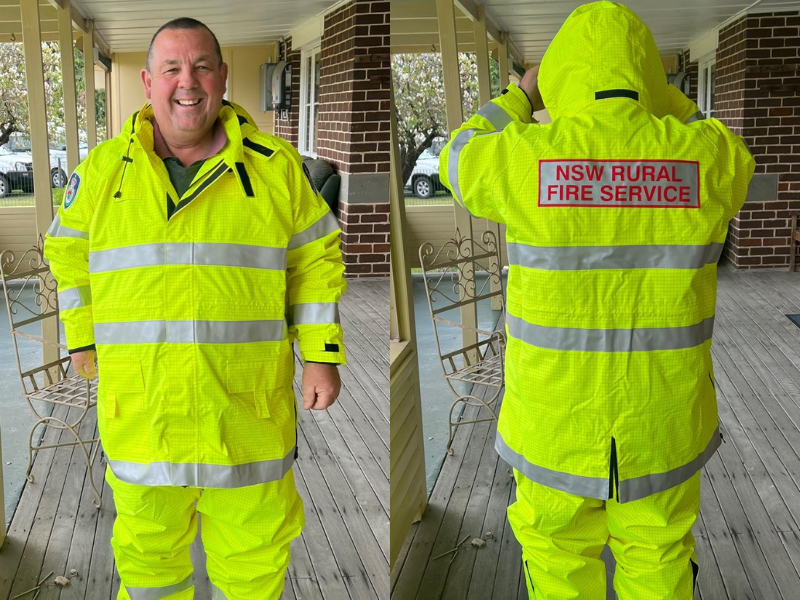
In Round 3 of the Volunteer Emergency Services Fund (VESF) grant program, Wallaby Joe RFS received a grant of $7,213 funded by the Lachlan and Sarah Murdoch Foundation to boost volunteer vitality with the provision of wet weather gear, helmet torches and emergency flares for use during community emergencies.
Gary Cox, Development Project Coordinator, Wallaby Joe RFS, says further deliveries are expected in the coming months.
“These garments have been delayed due to supply chain issues and high demand across a very wet New South Wales. The new wet weather gear complements the Eflares and helmet torches already acquired with your (FRRR’s) assistance and greatly adds to the safety and comfort of our volunteers. The brigade is most grateful for your generous support.”
Senior Deputy Captain, Rev Brian Ford models the new wet weather gear!
VESF is an FRRR program that aims to support the needs of local volunteer emergency services and first responders supporting communities affected by the Black Summer bushfires. This particular RFS’s recruitment soared after that terrible summer, and the procurement of operations equipment is a great example of how grants can help communities and their amazing volunteer services prepare for extreme weather event and natural disasters.
By Alli Mudford, People Portfolio Lead
The past few years, and especially 2021, have seen Australia’s remote, rural and regional communities hit by multiple disruptions, with successive events overlayed with relentless lockdowns. To quantify the impact of these disruptions on rural Australia, FRRR undertook a survey to see how these events had affected the local organisations, the ‘Heartbeat’ of rural communities.

Not surprisingly – at least not to us – the Heartbeat of Rural Australia study found that these locally-led community groups – more than half of which are entirely volunteer run – play a critical role in the vitality of these communities. Nearly 90% play an economic role and virtually all play a crucial role in the social and cultural life of the town.
So, when 30 percent of the 640 respondents report that they are deeply fatigued and others report exhaustion, or at worst, are simply burnt out, it is sobering.
The Heartbeat study revealed an overall decrease in volunteering in communities, at a time when it’s 75 percent harder to attract and maintain people in volunteer-based organisations, leaving the bulk of the work to the ‘stalwarts’ – the ‘stayers’ – to keep these critical local organisations ticking.
The report also found that since the beginning of 2020, the biggest change for volunteer-led organisations is less capacity, with nearly one third reporting reduced volunteer hours. A decrease in ‘incidental’ volunteering was also apparent – most likely attributable to a decrease in volunteer-run events such as the local ag show, music festivals and performances, many of which have struggled to proceed due to COVID-19 restrictions. The report also found that many community groups are now pondering if the events themselves will survive, and whether the people that are usually involved and volunteer their time to make them happen will still be around, if and when they get back up and running.
As one respondent in Rural Tasmania said, “All organisations we talk with are finding that modern life leaves many people too time poor to contemplate volunteering.”
So, are there any silver lining for Australia’s rural regions?
Well, we are seeing more rural migration, with city folk making the move to greener pastures – for a tree change, sea change, farm change. These big life moves in this disruptive period are possible with the support of flexible work conditions – the ability to work from home, work part-time hours, and in some areas, be supported by strengthened digital connectivity (although that is not the case everywhere!).
The Heartbeat of Rural Australia Report found that 38 percent of new volunteers are people who have migrated from larger town/cities. So, that has me wondering if this is in fact a ‘volunteering revolution’ and not the ‘great resignation’?
The ‘great resignation’ is certainly having a moment. However, I’m curious about how it is manifesting in Australia and what impact it will have on our rural communities, as we see people reflect, evaluate, and respond to their core values and their work life, as part of this cultural shift.
Is this the catalyst that rural communities need to be able to reflect and process these hard times and to move forward with a new ‘normal’?
For rural not-for-profits, is the emerging trend of regional migration going to open the door to a new and skilled workforce, with people choosing to work for a more values-aligned, impact-driven, community organisation? And therefore, perhaps, more local volunteers?
Interestingly, despite these willing volunteers and the well-documented challenges of recruiting paid staff, we are seeing an increasing number of not-for-profit organisations navigating their new ‘normal’ and seeking funds to invest in paid resources. The aim is to alleviate the burden on volunteers throughout this difficult period, while continuing to build organisational capacity. These paid positions are generally part-time, flexible roles that employ local people from either within the organisation itself or, in some cases, local skilled contractors. The latter could well be those same people new to town and are also willing to volunteer.
If we are seeing a change in the types of people who are volunteering, it begs the question of how volunteer-based organisations should respond and envelope this new workforce into their communities with welcoming and supporting arms. Because the study found that isn’t always the case.
Locally-based organisations may need to recognise that while these new volunteers don’t necessarily come with the local knowledge or content, they bring different skill sets, time, energy and a deep desire to belong to their new place of their choosing.
Some groups are doing it well. For example, in Leeton, the Rotary Club, in partnership with the Roxy Theatre, has seized the moment and invested funds from FRRR to build a Volunteer Bank that seeks to harness the skills of locals – from parking attendants, to caterers, and costume makers and all those in between. It is envisioned that the Volunteer Bank will have the capacity and human resources that can be called on for local events, productions, and fundraising.
So, perhaps the ‘great resignation’ is actually less about dissatisfaction, and more about keeping things simple; spending time doing what you love with who you love; investing in yourself; perhaps growing a side hustle; but, above all else, spending time wisely and consciously.
Cumulative disasters have taken a heavy toll and left local leaders in remote, rural and regional communities feeling “uncertain”, “frustrated”, and “tired/fatigued”, although hopeful, according to a study released today.

Commissioned by the Foundation for Rural & Regional Renewal (FRRR), a charity dedicated to supporting grassroots community groups and not-for-profits in remote, rural and regional Australia, the Heartbeat of Rural Australia survey sheds a light on these often unseen and unheard organisations and shares their firsthand experience of how non-metro communities are faring.
FRRR CEO Natalie Egleton, says that the study is among the first to attempt to quantify the critical role these groups play in remote, rural and regional communities, as well as what needs to change if they are to continue to deliver services that sustain rural communities.
“These organisations are vital to the health, wellbeing and prosperity of these communities. In particular, they provide vital social connections; manage and maintain critical community infrastructure; deliver essential services to community members; and a range of other supports.
“These small groups, most of which are not normally eligible for either government funding or philanthropic support, are the backbone of their communities, with nearly 90 percent of respondents saying they play some kind of economic role. Many are responsible for more than one aspect of life in their community and almost all play a critical cultural or social role.
“What this study really highlighted was that if they were to fold – which some told us could occur without additional support – the communities they serve may well ‘‘wither and die”. At the very least, there would be significant gaps in services, the burden for which would move to government and the private sector,” Ms Egleton explains.
The study highlighted a lack of digital connectivity is significantly hampering rural Australia’s ability to thrive, and to maintain critical social connections.
“Access to digital technology in rural Australia really hasn’t improved in decades. Even where there is connectivity, it is expensive. While external funding often covers the hardware, there is insufficient income to cover the ongoing operational costs such as WIFI access, managing cyber security and training volunteers.”
There were also key issues raised around workforce attraction (including housing availability), mobilisation and infrastructure, which smaller and more remote communities require tailored solutions to, according to Ms Egleton.
While more than half of respondents reported that uncertainty is of greatest concern to them, resulting in “increased general stress / mental health”, by far the most detrimental effect of the pandemic has been the inability to meet with one-another, resulting in isolation, reduced wellbeing, and increased stress – especially for those also recovering from disasters.
The onset of the pandemic weakened the ability of community organisations to play their various roles in the community, at a time when, for many, demand for their services increased. Many – especially organisations with revenue of less than $50,000 – saw significant reductions in income from not being able to run fundraising events and income-generating activities and, in some instances, funders redirecting their support.
“At a community group level, the disruption has been constant, with the effects of cumulative disasters topped off by the pandemic. This has left local communities in a constant state of anxiety and uncertainty.
“It’s also meant that community groups – more than half of whom are made up entirely of volunteers – are being called on to do more, for longer. The reality is that they are not resourced to endure this level of disruption. Yet, in many smaller communities, they simply have had to do it as there is no one else. That is fatiguing; that’s the pure exhaustion that we heard – the effort to keep focusing on your town, your small business community; keeping people connected and supported – especially when there are so few volunteers bearing the load,” notes Ms Egleton.
FRRR is calling for those that are concerned about rural communities to come together to better target support for rural, regional and remote not-for-profits and community groups.
“This report gives us a great opportunity to step back and consider how we can better support and resource these organisations to do what is critical work – and work that only they are really able to do effectively because they are in and of these places. At present, the broader funding mechanisms and policies don’t value these organisations in line with the contributions that they make.
“We are still working through the findings in detail, but it certainly points to an opportunity to come together – philanthropy, government, corporations and individuals – and explore how we can better support these groups for the long-term. We need to take a coordinated approach to removing many structural barriers that are evident in this research if we want rural Australia to prosper,” Ms Egleton explains.
To explore the full report, head to www.frrr.org.au/heartbeat. FRRR has also partnered with Seer Data and Analytics to make the full dataset available online. The data can be cross-referenced with other publicly available data, enabling community groups in particular to better advocate for the support that they need to survive.
FRRR will host two webinars to explore the findings in more detail. The first, focused more on community groups, will be held on Tuesday 30 November, and a session tailored to funders, policy-makers and the broader sector will be held on Wednesday 1 December. Both sessions will begin at 12.30pm AEDT and be held online. Register at www.frrr.org.au/heartbeat.
Grants available for services supporting communities impacted by Black Summer bushfires
A generous private donation of $1 million will fund FRRR‘s new Volunteer Emergency Services Fund Grant Program. The Program will fund volunteer emergency services to support their recovery needs from the 2019/20 bushfires and help them prepare for future challenges.
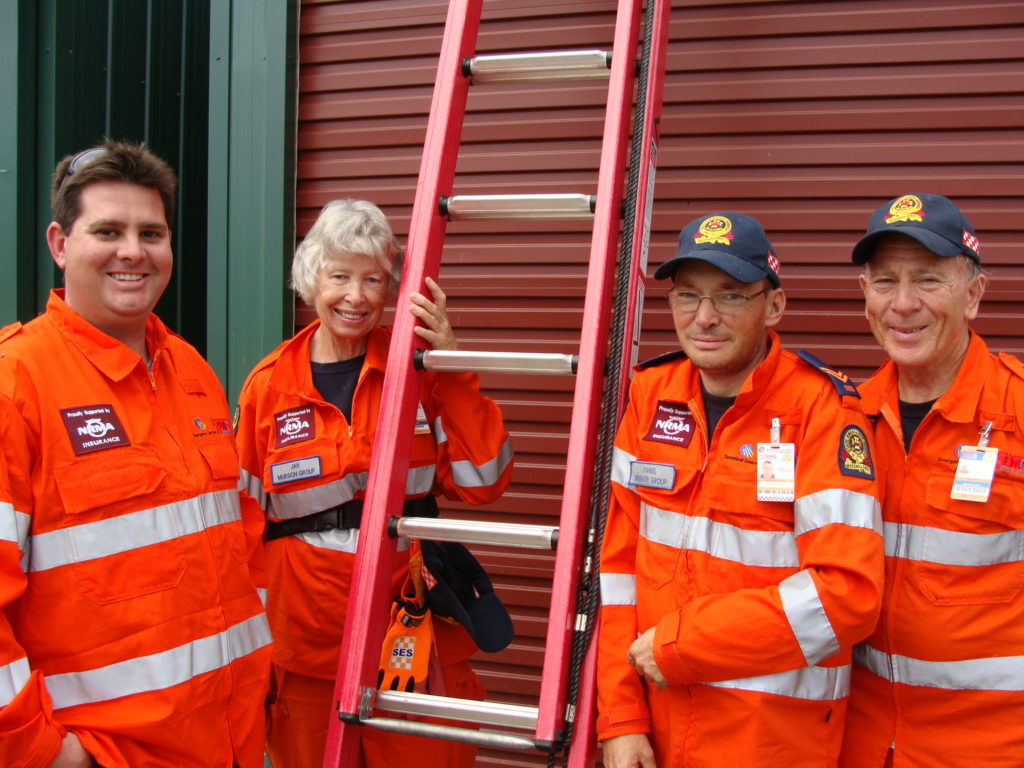
The Volunteer Emergency Services Fund will offer grants to local volunteer emergency services and first responder organisations in 2019/20 fire-affected regions across rural, regional, and remote Australia. Funds will help them to respond to local disaster recovery needs and address preparedness priorities ahead of the 2021/22 bushfire season.
Grants of up to $25,000 are available for projects including practical improvements and upgrades to facilities and equipment so that these services are better able to respond to future disasters. Initiatives that support the mental health and wellbeing of first responder volunteers, as well as projects that provide training and build the capacity of these services can also be funded.
Natalie Egleton, CEO of FRRR, said that an integral part of the recovery process is preparing for future disasters and adapting to changing conditions after a disaster.
“We know that disasters, like bushfires, are not isolated events. They are increasing in frequency and severity; and it is vital for our volunteer-led emergency services groups to be equipped,” Ms Egleton said.
“Throughout the 2019/20 summer bushfires, volunteer emergency and first responder services worked tirelessly to protect and save their communities. They literally saved lives.
“These grants will support those who support the community by funding projects that will help these volunteers process and heal from the trauma of the bushfires, as well as build resilience and preparedness for future disasters.
“We look forward to assisting these vital members of impacted communities and helping to build and strengthen the emergency services they so generously give their time to be a part of,” Ms Egleton said.
The Volunteer Emergency Services Fund Grant Program is now open. Applications close 5pm AEST 7 July 2021 with grants to be announced August 2021. For more information, visit FRRR’s website – https://frrr.org.au/funding/disaster-resilience-and-climate-solutions/volunteer-emergency-services-fund-grant-program/
Networks to Build Drought Resilience and Drought Resilience Leaders
FRRR will soon be providing increased support into remote, rural and regional communities to prepare for the impacts of drought, after being selected by the Australian Government to deliver its Networks to Build Drought Resilience program. FRRR is also part of a consortium delivering the Drought Resilience Leaders program.
Funded through the Australian Government’s $5 billion Future Drought Fund, both programs will help remote, rural and regional people access the tools, skills and support to build and foster leader networks, and to develop and roll out drought resilience initiatives in their communities.
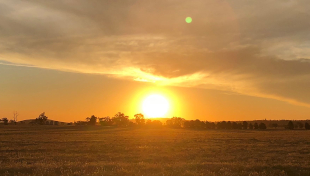
The Networks to Build Drought Resilience (NBDR) program will help people in agricultural communities to develop skills, participate in risk management planning, and foster projects that encourage connectedness and improve wellbeing. It will also support small-scale infrastructure projects to make community facilities drought resilient to increase overall wellbeing and reduce social isolation.
Natalie Egleton, CEO of FRRR, said that the Networks to Build Drought Resilience program will support future-focussed initiatives led by local community groups and network organisations that play such a vital role in local and regional resilience
“Networks and community leadership are the backbone of strong, vibrant communities and are essential to ensuring future preparedness for drought and the associated social, economic, environmental impacts that can be so devastating for remote, rural, and regional communities.
“This is an exciting opportunity for building drought resilience from the ground up and we look forward to supporting the fantastic ideas and solutions that we know are ready to go across the country,” Ms Egleton said.
Through the Drought Resilience Leaders (DRL) program rural leaders will be able to access training and support that will help them to develop and undertake a project to build drought resilience in their communities. Partnering with the Australian Rural Leadership Foundation (ARLF) and the Rural Economies Centre of Excellence (RECoE), FRRR will manage a grants stream that will allow leadership program participants and their communities to activate their community-strengthening ideas.
Ms Egleton said that this program means more opportunities for local people to take the lead in finding meaningful and tailored solutions for their community’s increased climate resilience.
“Local leaders know how to get things done. They know how to bring people together, to motivate and to problem-solve. Backing these leaders is key to ensuring the long-term vitality of Australia’s remote, rural and regional communities, particularly those battling drought.
“We are thrilled to be partnering with the ARLF and RECoE to provide these local leaders with access to such invaluable training and help them to bring their drought resilience projects to life,” Ms Egleton said.
For more information visit
The Hon David Littleproud MP – https://minister.awe.gov.au/littleproud/media-releases/drought-leaders-networks-programs
Australian Rural Leadership Foundation – https://rural-leaders.org.au/arlf-to-lead-consortia-to-deliver-drought-program/
In 1979, an idea was formed between a bunch of country music loving mates over a few drinks around a campfire in the south west of WA. It became the Country Music Club of Boyup Brook (CMCBB), and before long, they were putting on a show on a regular basis.
Since 1986, the Boyup Brook Country Music Festival has been a major drawcard for this small farming community, attracting more than 10,000 visitors. The CMCBB does a lot more than put musicians on a stage though – there is a strong commitment to upskilling and training it’s volunteers and trainees in all aspects of event planning, including administration, bookkeeping, budgeting, grant writing, event management and office procedures, supporting them to gain financial literacy and job readiness skills. This benefits a core group of 20 volunteers that contribute to pre-planning throughout the year, and 150 during the Festival weekend. The Festival also provides the main fundraising event for more than 36 local community groups that participate during the weekend.
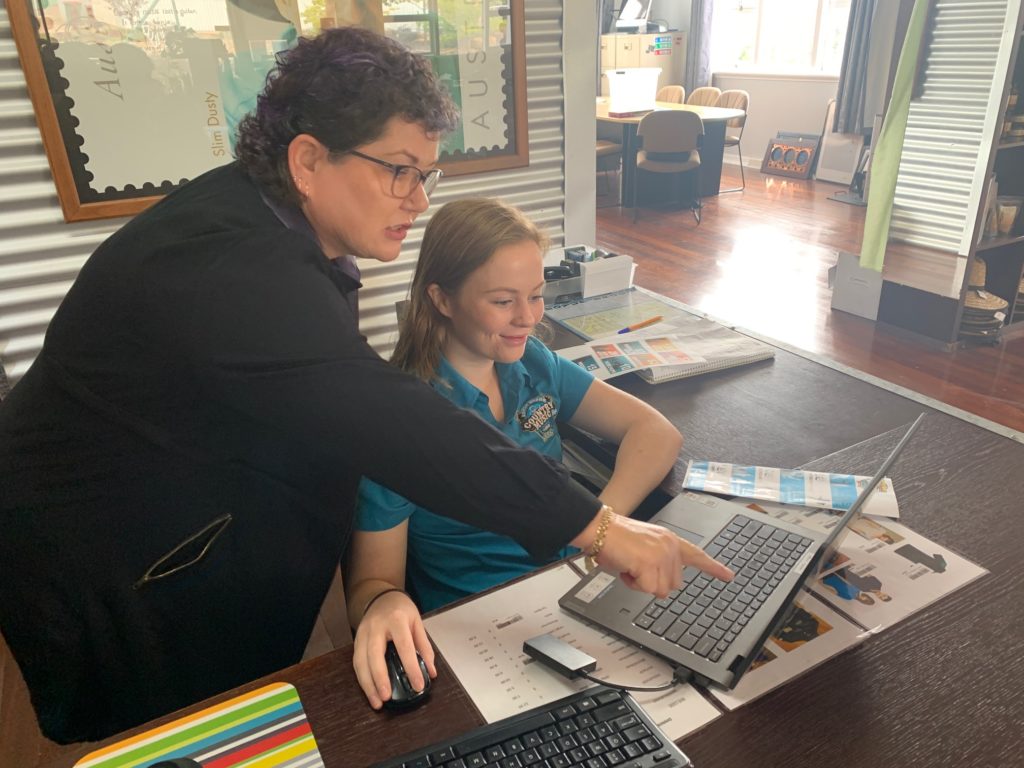
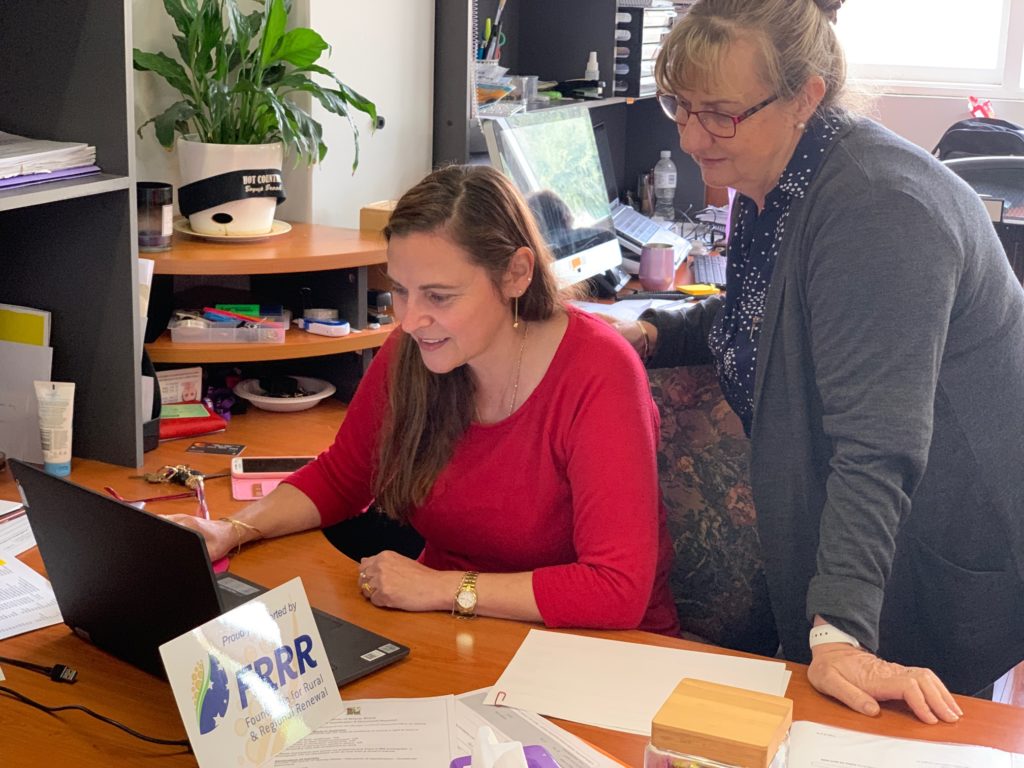
A couple of bad years recently set the club back: in 2017, flooding required the festival to be relocated; and in 2018 the club was hit by a sophisticated ticket scamming operation. On top of all this, the IT equipment available to the group was ageing and unreliable, often freezing unpredictably. Two of the computers were classed as ‘vintage’ by Apple, and the club said they could take a “very long time before they decide to boot up and one makes a noise like crickets are in the building.” This hurdle was adversely affecting the efficiencies and upskilling of the core group volunteers, not to mention the security of ticket sales and smooth running of the festival. But the tough luck the Club had run into had affected their capacity to invest in new equipment.
Daly and Sharon Winter, CMCBB’s President and Music Director, say the Festival helps a small rural community build a vibrant and sustainable community.
“It has wider audience appeal with a multiplier effect for injecting new capital into the local economy, and improves financial well-being within our community. The Festival is a celebration of our country lifestyles and community spirit. The event encourages hundreds of visitors to our state, providing a great boost to our tourism.”
Through the ANZ Seeds of Renewal program, the Club was successful in gaining new equipment. Via the Lenovo stream of the program, the Club was delivered three new Lenovo Thinkpads to support the events future operations, productivity and skill development of the group and volunteers.
The Club also plans to train staff and volunteers to scan, edit, and save photographs and documents to preserve its history as one of the oldest Incorporated Country Music Clubs in Australia and Western Australia.
Some of the volunteers use the equipment throughout the year, and under the guidance of the committee a young employee of the club recently completed her Certificate II and III in Business, plus Event Management modules. In their report, the Club wrote: “Learning new skills through the Club has led past volunteers to new employment options and keeps people living within our rural town and region.”
Nicki Jones, a volunteer, was ecstatic when the new laptops arrived, and with them, she says she achieved much more than she anticipated.
“Not only were they efficient, user friendly and supported current applications, they had a webcam and sound! This might initially sound silly, but in the big picture, this allowed me to join webinars and learn new software packages and how to use the computer to better capacity. I found one of the new software packages extremely useful and have now produced several documents with it for the Club. These documents are up to date, professional and easy to read.”
The experience and access to technology, she said, has built her self-esteem and confidence, and she has since been successful in seeking full-time employment, bringing her new skills to her position.
“I cannot thank FRRR and ANZ enough for making life so much easier.”


